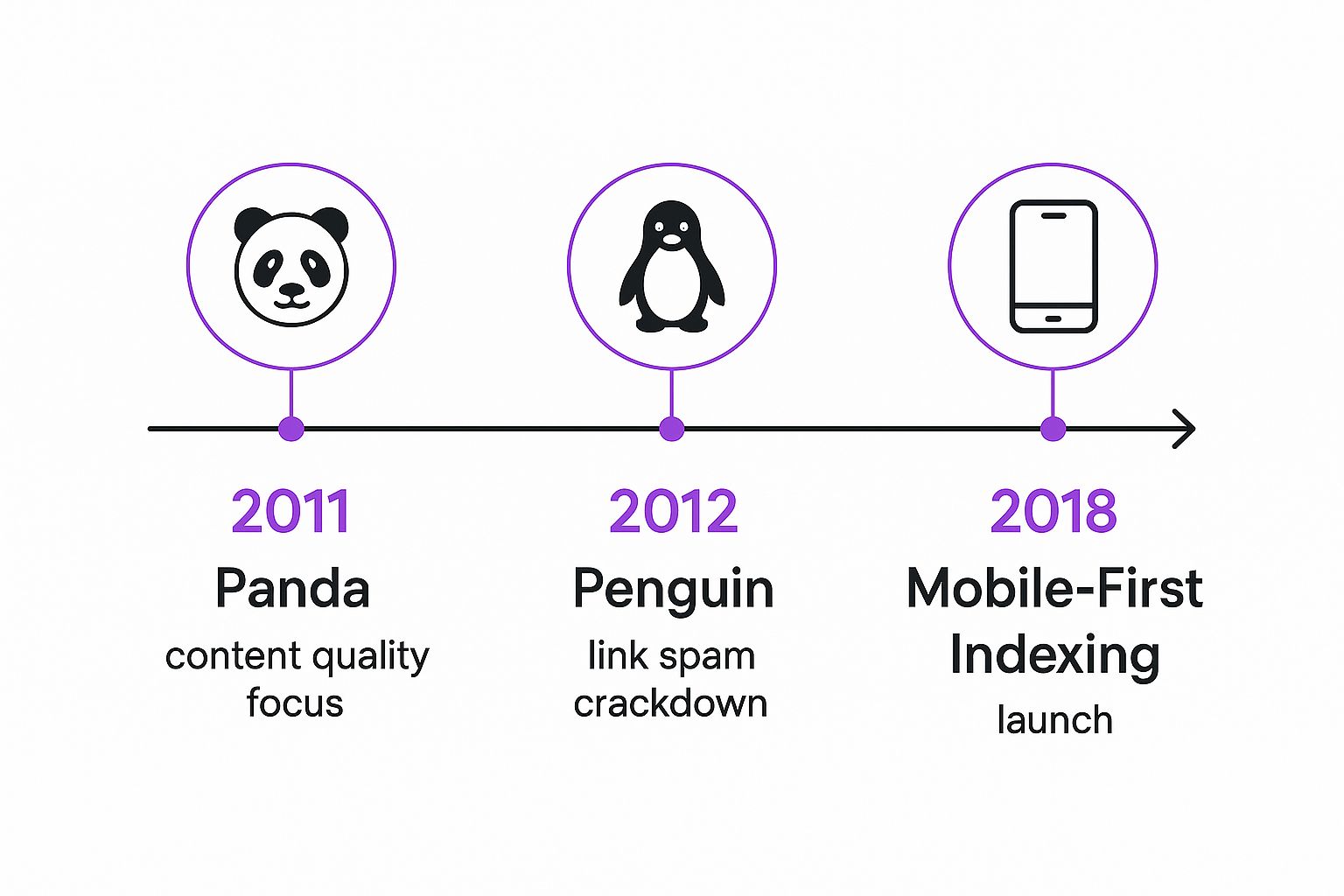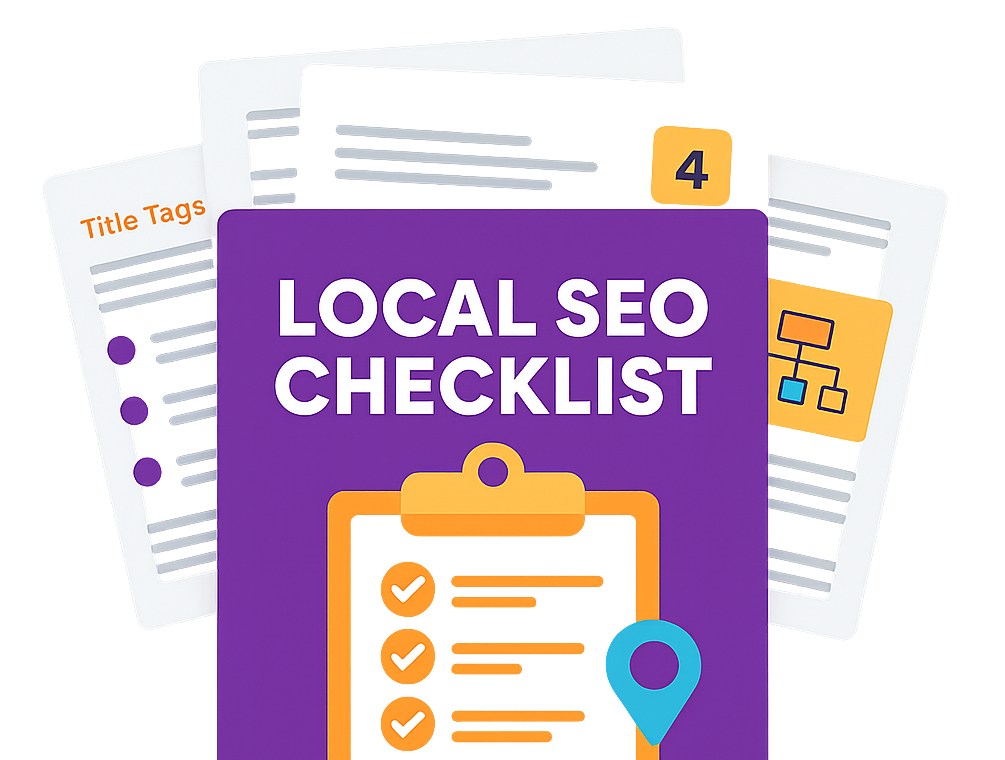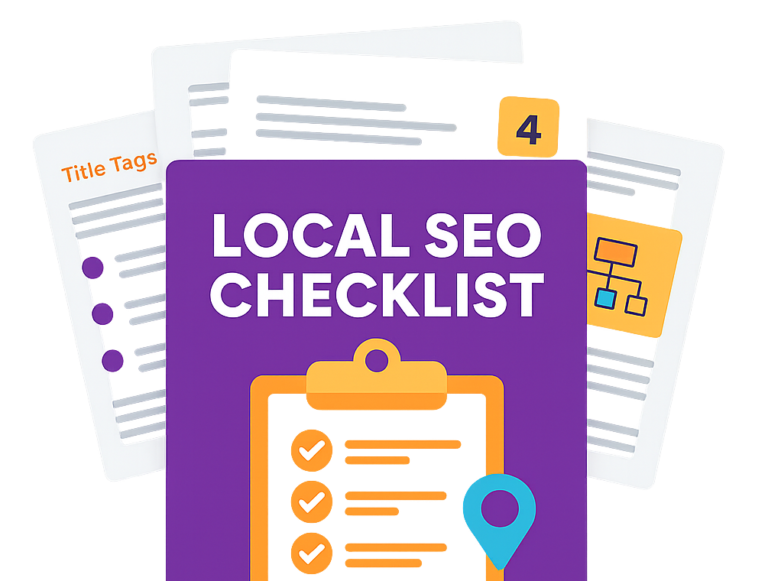Google's algorithm is in a constant state of flux. The search giant is always making changes to the complex system it uses to rank websites, all in the name of delivering more relevant and reliable results.
These updates fine-tune how web pages are evaluated for quality and user intent, which means what worked for you yesterday might not work tomorrow.
Demystifying Google Search Algorithm Updates

Think of Google's search algorithm like a chef's secret recipe for serving up the best possible search results. It mixes hundreds of ingredients—everything from keywords and backlinks to site speed and mobile-friendliness—to decide which pages land on your screen. Google search algorithm updates are simply tweaks to that recipe.
These changes happen all the time. In fact, Google makes thousands of minor adjustments every single year. Most of them are so small they fly completely under the radar, subtly improving results without anyone really noticing.
But a few times a year, Google rolls out a major update that can seriously shake up the search engine results pages (SERPs). And those are the ones you hear about.
Core Updates vs. Minor Adjustments
It’s really important to know the difference between the two main types of changes. Minor adjustments are the daily tweaks, the background hum of search optimisation. They're all about continuous, incremental improvements and don't typically cause major disruptions.
On the other hand, the big "core updates" are a much bigger deal. These are broad changes to the central algorithm that can cause noticeable shifts in website rankings across every industry. A core update isn't aimed at specific websites; instead, it re-evaluates ranking signals across the board.
A core update isn't a penalty. It’s a re-evaluation of your website against competitors, based on new quality signals. The goal is to better reward pages that offer the most helpful and reliable user experience.
The Purpose Behind the Updates
Every single update, big or small, shares one ultimate goal: to improve the quality and relevance of search results for the user. Google's entire business model depends on people trusting it to find what they're looking for quickly and accurately.
To make that happen, the algorithm has to get better at understanding a few key things:
- User Intent: What does someone really want when they type something into the search bar?
- Content Quality: Which pages offer genuine expertise, authority, and trustworthiness?
- User Experience: Is the website easy to use, fast, and secure?
By constantly refining its recipe, Google is essentially pushing website owners towards better practices. This focus on improvement is critical for anyone trying to figure out how to improve Google search rankings for the long haul.
Ultimately, these updates reward sites that provide genuinely helpful content and penalise those using manipulative tricks. Getting your head around this is the first step to building an SEO strategy that doesn't just survive these changes but actually thrives because of them.
A Journey Through Landmark Google Updates
To really get your head around modern SEO, you have to look back at the moments that got us here. The history of Google’s algorithm updates isn’t just a dry list of technical tweaks; it’s the story of a search engine’s obsession with quality. It’s about Google’s evolution from a simple keyword-matching machine into something much, much smarter.
When you look at the big updates that shook up the industry, a clear pattern shows up. Time and again, Google has moved to crush spammy tactics while rewarding websites that actually help people. Understanding this history is the key to building an SEO strategy that lasts.
This timeline hits the major highlights, showing how Google’s focus has shifted from dodgy content and spammy links to the mobile experience we all expect today.

You can see how Google keeps raising the bar, forcing everyone to get better at what they do.
The Panda Update: Content Quality Revolution
Remember the internet before 2011? It was littered with "content farms"—sites that pumped out thousands of low-quality, barely readable articles just to rank for keywords. They offered zero real value and made searching for anything a total nightmare.
Then, the Panda update dropped. It was a complete game-changer, specifically designed to hunt down sites with thin, duplicated, or just plain useless content. For the very first time, an update was built to judge a site's overall content quality on a massive scale.
Panda wasn't just another update; it was a line in the sand. Google sent a clear message: just having content isn't good enough anymore—it has to be good.
Sites with terrible user engagement, sky-high bounce rates, and shallow articles saw their rankings absolutely tank overnight. This update drove home a lesson that’s still at the core of SEO today: quality always beats quantity. It forced the entire industry to stop stuffing keywords and start creating content that genuinely helps people.
The Penguin Update: Link Spam Crackdown
Hot on the heels of Panda, the Penguin update arrived in 2012 to clean up another huge mess in the SEO world: link building. Back then, you could climb the rankings by buying thousands of rubbish backlinks from irrelevant sites, dodgy blog networks, and paid directories. It was the wild west.
Penguin was built to devalue all of these manipulative link schemes. It started analysing a site’s backlink profile for quality and relevance, handing out penalties to anyone relying on unnatural links.
The impact on the SEO industry in the UK was massive. Penguin forced businesses to ditch these black-hat tactics and focus on earning high-quality, relevant links through great content and real outreach. It taught us that not all links are created equal—a handful of authoritative links are worth far more than thousands of spammy ones.
The Hummingbird Update: Rise of Semantic Search
Released in 2013, the Hummingbird update wasn’t just a patch—it was a complete rebuild of Google’s core algorithm. While Panda and Penguin were like add-ons, Hummingbird was a brand-new engine built to understand the meaning behind what people were searching for.
Instead of just matching individual keywords, Hummingbird allowed Google to understand the context of a whole sentence. This was the beginning of semantic search, where the algorithm started focusing on user intent.
For example, a search for "best place to change pounds to euros near Cambridgeshire" was now understood as a complete thought, not just a random string of words. Google could deliver much more accurate answers because it understood synonyms, context, and how different concepts relate to each other.
This update paved the way for voice search and the conversational queries we use today. It proved that to win at SEO, you need to create content that directly answers your audience's questions, not just targets their keywords. Staying on top of these shifts is crucial, and you can see what’s coming next by checking out the latest SEO trends for 2023.
Navigating Core And Helpful Content Updates

While the big, named updates set the original rules of the game, modern SEO is really dictated by two ongoing forces: Broad Core Updates and the Helpful Content System. Getting your head around how these two work together is essential for any UK business that wants to stay visible in the long run. Think of them as Google's continuous effort to reward sites that genuinely care about their users.
First things first, it’s vital to understand that a Broad Core Update isn't a penalty. It’s more like a system-wide recalibration. Google is essentially taking a step back and reassessing how it values different signals to figure out which pages offer the most trustworthy and relevant answers.
This is precisely why these updates can cause such a stir in the rankings. A signal that Google saw as a strong indicator of quality last month might be weighed completely differently this month, leading to a major shuffle in the search results.
Understanding The Impact Of Core Updates
Google rolls out several of these broad core updates every year, and they have a huge hand in shaping the UK search results. In 2023, for example, we saw four major core updates, with the November 2023 update making particularly big waves. These events change how Google assesses relevance and trust, causing significant ranking shifts and traffic dips for many websites—especially in sensitive fields like healthcare and finance.
To be clear, Google makes thousands of tiny tweaks all the time, but it’s these core updates that really shake things up and keep the search results reliable. You can find more detailed analysis on the UK impact of these updates over at Edge of the Web.
For UK websites in those sensitive sectors—what Google calls “Your Money or Your Life” (YMYL) topics—the impact can be particularly sharp. We're talking about sites that give financial advice, medical information, or legal guidance.
For YMYL content, Google’s quality standards are exceptionally high. A core update will rigorously scrutinise signals of expertise, authoritativeness, and trustworthiness, as these topics can directly impact a person's wellbeing.
This is why a health blog written by a well-meaning enthusiast might suddenly drop in the rankings, replaced by a page written by a certified doctor. Google is simply getting better at identifying and promoting true expertise where it matters most.
Introducing The Helpful Content System
Working hand-in-hand with core updates is the Helpful Content System. This started as a one-off update but has since evolved into a constantly running signal. Its entire purpose is to sniff out and demote content that was clearly made just to please search engines, not people.
The system specifically targets content that leaves a user feeling unsatisfied. Its goal is to make sure that when you click on a search result, you land on a page with original, insightful information that actually answers your question—not just some shallow, keyword-stuffed article.
A critical point to remember about the Helpful Content System is that its effect is site-wide. If Google decides your website has a significant amount of unhelpful content, it can drag down the rankings of all your pages, even the good ones.
Creating A Recovery And Resilience Plan
If your site traffic takes a nosedive after a Google update, the worst thing you can do is panic. The best approach is a structured one. A solid recovery plan isn't about finding quick fixes; it's about realigning your entire website with Google's core quality principles.
Here’s a simple framework to help you assess the damage and plan your next steps:
- Analyse Your Content: Put yourself in your users' shoes. Does your content show real, first-hand experience and deep knowledge? Or does it sound like it was written for a robot? Be honest.
- Embrace E-E-A-T: Build your entire strategy around Expertise, Experience, Authoritativeness, and Trustworthiness. This means clear author bios, citing credible sources, and showing off your credentials.
- Improve User Experience: A slow, clunky, or confusing website sends all the wrong signals. A poor user experience is a major red flag for quality. Getting a handle on this is much easier by utilising Core Web Vitals tools.
- Remove or Refresh: Do a thorough content audit. Identify low-quality, unhelpful pages and either improve them drastically or get rid of them. Pruning weak content can boost your site's overall quality profile in Google's eyes.
Ultimately, navigating Google's updates is about a shift in mindset. Instead of constantly reacting to changes, you should be proactively building a website that's genuinely valuable to your audience from the start. This people-first approach is the only sustainable way to build an SEO strategy that lasts.
How AI Is Reshaping Content Quality Signals
AI has brought about the most significant shift in SEO we've seen in years. While it offers incredible potential to work more efficiently, it's also responsible for flooding the web with low-quality, unoriginal content at a frightening scale. In response, recent Google search algorithm updates have taken a firm stance—not against AI itself, but against its misuse.
Google's official position is refreshingly clear: their focus is on the quality of the content, not how it was created. Content that is genuinely helpful, reliable, and backed by real expertise will be rewarded, whether a human, an AI, or a blend of both was involved. On the flip side, content created purely to game the search rankings is now squarely in their crosshairs, regardless of where it came from.
This distinction is absolutely crucial. Using AI as a brainstorming partner, a tool for structuring an article, or a way to get past writer's block is perfectly fine. But relying on it to churn out generic articles with zero human oversight is a high-risk strategy that recent updates are designed to penalise.
The Crackdown On Low-Value AI Content
We're not just talking theory here; recent algorithm changes have shown a sophisticated ability to spot and devalue content that lacks originality and depth. The real-world impact has been swift and severe for those who misjudged where Google was heading.
One of the biggest recent events was the March 2024 Core Update. It took a surgical approach to reducing unhelpful content across the web. The rollout was huge, taking a full 45 days to complete, and its effects were felt everywhere, including right here in the UK. Google reported that the update helped it cut down approximately 40% of low-quality, unoriginal content from its search results. In the first week alone, over 800 websites were completely de-indexed, wiping out an estimated 20.7 million monthly visits in organic traffic.
When the dust settled, analysis of the penalised sites revealed a clear pattern: 50% of them contained nearly 90-100% AI-generated content. For UK businesses, the financial fallout was massive, with an estimated loss of over £358,000 per month in organic traffic value.
Using AI Responsibly For SEO Success
The key takeaway from all this isn't to ditch AI tools. It's to integrate them thoughtfully into a human-led content strategy. AI should be treated as a powerful assistant, not a substitute for human expertise, creativity, and critical thinking. Successful SEO now relies on a blended approach.
AI can speed up the process, but it can't replicate genuine experience or insightful analysis. The final content must always be filtered through the lens of a human expert to ensure it’s accurate, original, and actually serves the user’s needs.
Here are a few practical ways to use AI responsibly in your content workflow:
- Ideation and Outlining: Use AI to brainstorm topics, generate article outlines, or explore different angles. It’s a fantastic tool for breaking through a creative block.
- Drafting, Not Finalising: Let an AI produce a first draft, but never, ever publish it as-is. Your team needs to take the reins to edit, fact-check, and inject unique insights, personal experience, and your brand's voice.
- Enhancing Human Content: Use AI tools to improve what you’ve already written. Ask it to suggest better headings, optimise for readability, or spot any information gaps you might have missed.
By following these principles, you can get the efficiency benefits of AI without falling foul of Google’s quality standards. If you want to dig deeper into how these models work and how to use them effectively, you might find our guide on what LLMs mean for your SEO strategy useful. The goal is always to produce content that is valuable and people-first, ensuring it remains resilient against future google search algorithm updates.
Building a Future-Proof SEO Strategy

Trying to react to every single google search algorithm update is a surefire way to burn out. It feels like you're constantly playing defence, never quite getting ahead. A much smarter, more sustainable approach is to build a proactive strategy grounded in principles that don’t really change.
This is about moving away from chasing algorithms and focusing on one simple thing: creating genuine value for your audience.
A truly future-proof SEO strategy isn't about finding clever loopholes. It's about building a fundamentally brilliant website that Google wants to rank highly. This means committing to quality across three core pillars: your content, your authority, and your site's technical health. Get these right, and you align your website with Google's own long-term goals, making your rankings far more stable.
It all starts with a relentless focus on the user.
Prioritise User Intent Over Keywords
The days of just stuffing keywords into a page are long gone. Modern SEO is all about understanding the "why" behind every search. Is someone looking for information? Are they comparing products? Or are they ready to buy right now? Creating content that directly and thoroughly answers these questions is the only reliable path to success.
Take the BERT update back in 2019. This was a huge shift, affecting around 10% of all searches by helping Google understand the nuance and context in longer phrases. This was a clear signal that Google is getting better at rewarding content that truly gets what a user is looking for, especially for conversational, long-tail queries.
Conduct Regular Content And Authority Audits
Think of your website as a living thing; not all of its parts are going to perform equally well forever. Auditing your content regularly is crucial for maintaining a high standard of quality across the board. It’s how you find and fix the pages that are no longer pulling their weight.
At the same time, you need to be building a natural and authoritative backlink profile. This is what signals to Google that your site is a trusted resource in your field.
A proactive SEO strategy isn't about a one-time fix. It’s a continuous cycle of auditing, refining, and improving your content and technical foundation to consistently meet user expectations.
If you run an e-commerce site, implementing the right 10 Shopify SEO best practices is a fantastic way to adapt and build a more resilient online store.
Maintain Impeccable Technical Health
You can have the best content in the world, but if your website is slow, clunky, or broken, it's going to struggle. A solid technical SEO foundation is non-negotiable—it's the platform that allows your great content to actually shine. A healthy site is fast, secure, mobile-friendly, and easy for search engines to crawl.
Regularly checking these elements ensures you aren’t accidentally holding yourself back. A simple checklist can make all the difference.
Here’s a quick 'health check' to get you started:
- Site Speed: Does your site load quickly on both desktop and mobile? Slow loading is a killer for user experience and rankings.
- Mobile-Friendliness: Is your website genuinely easy to use on a smartphone? With mobile-first indexing, this is an absolute must.
- Crawlability and Indexability: Can search engine bots easily find and understand your pages? A quick check in Google Search Console will reveal any crawl errors.
- Secure Connection (HTTPS): Is your website secured with an SSL certificate? It's a confirmed (though minor) ranking signal.
These checks are the backbone of a resilient website. For a more detailed walkthrough, our technical SEO audit checklist with 15 essential elements will make sure you don't miss a thing.
Got Questions About Algorithm Updates? We've Got Answers
It’s completely normal to feel a bit lost when Google rolls out another algorithm update. The jargon can be confusing, and the impact isn't always clear. Here are some straightforward answers to the questions we hear most often.
How Can I Tell If An Algorithm Update Has Affected My Website?
The classic sign is a sudden, sharp nose-dive in your organic traffic that lines up perfectly with a known update announcement. The first place you should look is your Google Search Console ‘Performance’ report—a big, unexpected dip in clicks and impressions is your red flag.
But hold on before you panic. It’s crucial to rule out other culprits first. Could it be a seasonal slump? Did you just push a major website change? Are there any technical gremlins hiding on your site? The most reliable way to know for sure is to check your data against industry news about recent algorithm rollouts. If the dates match, you’ve probably found your answer.
What Should I Be Focusing On For Long-Term SEO Success?
Hands down, the single most important thing is to consistently create high-quality, genuinely helpful content that solves your audience's problems. While the technical side of SEO is definitely important, Google's updates have repeatedly shown they favour content that demonstrates real expertise and offers a fantastic user experience.
Instead of chasing every new algorithm trend, pour your energy into becoming the absolute best, most trusted resource in your field. This user-first mindset is the most reliable, future-proof SEO strategy there is.
How Long Does It Take To Recover From A Core Update Hit?
This is the tough one. Recovery times vary wildly, and to be blunt, it’s never guaranteed. If a core update has knocked your site down, it means Google’s systems have reassessed your pages and found them less relevant or authoritative than your competitors'.
Getting back on track involves making significant, site-wide improvements. We're talking about a deep dive into your content quality, user experience, and overall trustworthiness. You might not see any positive changes until the next broad core update rolls out, which could be months away. It’s a process that demands patience and a real commitment to fundamental fixes, not quick, cosmetic tweaks.
Should I Stop Using AI To Create Content For My Website?
No, but you absolutely have to use it smartly. Google isn't against AI itself; it's against low-effort, unoriginal content churned out at scale just to game the rankings. Using AI as a brainstorming partner, to help structure an outline, or even to get a first draft down is perfectly fine.
The danger lies in publishing raw AI output without a thorough human touch. Fact-checking, adding unique insights, and injecting your brand's voice are non-negotiable. Think of AI as an assistant, not the author. Your final, published piece needs to be original, helpful, and prove there’s a real expert behind it.
At Bare Digital, we keep our finger on the pulse of every Google update so you don’t have to. Our specialist SEO services focus on building resilient, long-term strategies that deliver real growth. See how we can help your business thrive with a free, no-obligation SEO health check. Learn more at Bare Digital.








